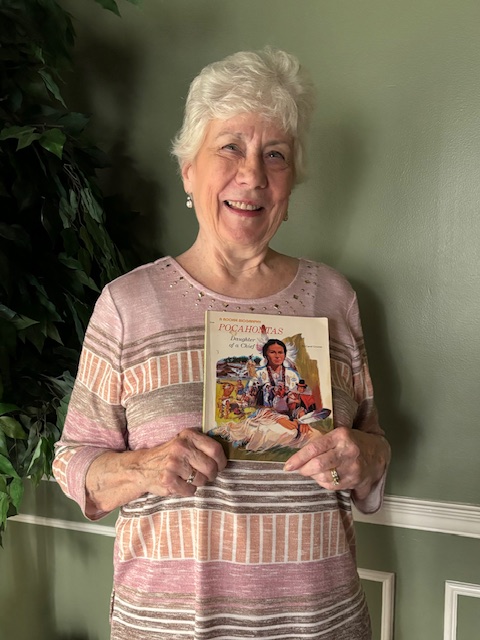Dames hear the real story of Pocohontas
Published 2:48 pm Tuesday, November 26, 2024

- MEET MY ANCESTOR:Dr. MaryFriend Carter, Descendant of Pocahontas, who gave program to Dames, holding childrens' book on Pocahontas. (Submitted Photo)
THOMASVILLE- Dr. MaryFriend Carter presented the program, “Pocahontas, My Tenth Great Grandmother” at a recent John Lee of Nansemond Chapter, National Society Colonial Dames Seventeenth Century meeting. Carter is descended from John Rolfe and Pocahontas’ only child, a son, Thomas Rolfe.
Pocahontas was born about 1596 and given the name Amonute. Pocahontas was a nickname which meant “playful one” because of her curious and adventuresome character. She was the daughter of Wahunsenaca (Chief Powhatan), a very important chief of the Algonquin-language Indians. Being so privileged, she was still instructed in all the jobs of ordinary Indian women such as building homes, planting, harvesting, cooking, gathering firewood, making mats, baskets, and pots.
When the English arrived in Jamestowne, May, 1607, Pocahontas was approximately eleven years old. She and her father met Captain John Smith in the winter of that year. Twice she saved Smith’s life. The English recognized Pocahontas as a sign of peace.
Trending
Later relations between the English and the Indians deteriorated. Pocahontas was captured and held for ransom. During her captivity, she learned the English language, religion, and customs from the Reverend Alexander Whitaker. During this time, she met a widower, John Rolfe, and subsequently they fell in love. Pocahontas converted to Christianity and was baptized as “Rebecca,” meaning “mother of two people.” She and Rolfe were married in 1614. They traveled to England in 1616 to promote Jamestowne to the English. She was known as Lady Rebecca Rolfe, the Civilized Savage. Preparations were made for the return trip to the Colonies in March, 1617. While on the ship, Pocahontas and John dined with Captain Argall. Shortly after dinner, Pocahontas became very ill, convulsing and dying quickly. It was rumored that she might have been poisoned since she was quite healthy up until dinner. Some other theories of the cause of her death were from pneumonia, tuberculosis, or maybe dysentery. The truth of the cause of her death will probably never be known. Her body was taken ashore and buried either under the altar of St. George’s Church or in the graveyard of the church at Gravesend, Kent, England.
The Rolfe’s young son, Thomas, remained in England to be reared and educated by John’s relatives. John returned to Virginia and kept his tobacco industry going. As a young man, Thomas went to the Colonies and assisted his father in the business.
As a memorial to Pocahontas, a life-sized statue of her was placed in the gardens of St. George’s Church. The original church was destroyed by fire in the 18th Century. The National Society Colonial Dames Seventeenth Century maintains the gardens and the statue is a replica of the Jamestowne, Virginia statue.
Doris Davies presented the Colonial Minute, a short Colonial event or person, at the meeting. She chose as her topic Colonial Taverns. Taverns served the same purpose as our hotels and restaurants today. Only the most well-respected members of the community were allowed to own taverns. There were very strict laws governing the taverns. During this time, many people could not read so the signs designating taverns were pictures of objects or animals. For example, if the tavern name was “The Black Swan,” on the sign was a painting of a black swan. For those whose lineal ancestors were tavern owners, there is a genealogical organization today called “Flagonand Trencher Society,” the flagon being a pitcher and the trencher a hollowed-out wooden tray to hold food.
The Dames have completed their next community service project, the decorating of the dining room for Christmas at the Historic Lapham-Patterson House on North Dawson Street, Thomasville, Georgia.





